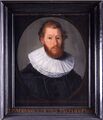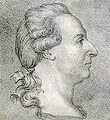Template:Selected anniversaries/September 6: Difference between revisions
No edit summary |
No edit summary |
||
| (12 intermediate revisions by the same user not shown) | |||
| Line 1: | Line 1: | ||
<gallery> | <gallery> | ||
||1492: Christopher Columbus sails from La Gomera in the Canary Islands, his final port of call before crossing the Atlantic Ocean for the first time | ||1492: Christopher Columbus sails from La Gomera in the Canary Islands, his final port of call before crossing the Atlantic Ocean for the first time. | ||
||1522: The Victoria, the only surviving ship of Ferdinand Magellan's expedition, returns to Sanlúcar de Barrameda in Spain, becoming the first ship to circumnavigate the world. Pic. | ||1522: The ''Victoria'', the only surviving ship of Ferdinand Magellan's expedition, returns to Sanlúcar de Barrameda in Spain, becoming the first ship to circumnavigate the world. Pic. | ||
File:Adriaan Metius.jpg|link=Adriaan Metius (nonfiction)|1635: Mathematician and astronomer [[Adriaan Metius (nonfiction)|Adriaan Metius]] dies. He manufactured precision astronomical instruments, and published treatises on the astrolabe and on surveying. | File:Adriaan Metius.jpg|link=Adriaan Metius (nonfiction)|1635: Mathematician and astronomer [[Adriaan Metius (nonfiction)|Adriaan Metius]] dies. He manufactured precision astronomical instruments, and published treatises on the astrolabe and on surveying. | ||
| Line 13: | Line 13: | ||
File:Johan Carl Wilcke.jpg|link=Johan Wilcke (nonfiction)|1732: Physicist and academic [[Johan Wilcke (nonfiction)|Johan Carl Wilcke]] born. He will invent the electrophorus, and calculate the latent heat of ice. | File:Johan Carl Wilcke.jpg|link=Johan Wilcke (nonfiction)|1732: Physicist and academic [[Johan Wilcke (nonfiction)|Johan Carl Wilcke]] born. He will invent the electrophorus, and calculate the latent heat of ice. | ||
||1853: George Bradshaw dies ... cartographer, printer and publisher. He developed Bradshaw's Guide, a widely sold series of combined railway guides and timetables. Pic. | |||
||1857: Johann Salomo Christoph Schweigger dies ... chemist, physicist, and professor of mathematics. Pic. | ||1857: Johann Salomo Christoph Schweigger dies ... chemist, physicist, and professor of mathematics. Pic. | ||
||1859: Boris Yakovlevich Bukreev born ... mathematician and author. Pic. | |||
File:John Dalton by Charles Turner.jpg|link=John Dalton (nonfiction)|1766: Chemist, meteorologist, and physicist [[John Dalton (nonfiction)|John Dalton]] born. He will propose the modern atomic theory, and do research in color blindness. | File:John Dalton by Charles Turner.jpg|link=John Dalton (nonfiction)|1766: Chemist, meteorologist, and physicist [[John Dalton (nonfiction)|John Dalton]] born. He will propose the modern atomic theory, and do research in color blindness. | ||
| Line 32: | Line 36: | ||
||1885: Engineer and artist Narcís Monturiol dies. He invented the first air-independent and combustion-engine-driven submarine. Pic. | ||1885: Engineer and artist Narcís Monturiol dies. He invented the first air-independent and combustion-engine-driven submarine. Pic. | ||
||1892: Edward Victor Appleton born . | File:Edward_Victor_Appleton_(1947).jpg|link=Edward Victor Appleton (nonfiction)|1892: Physicist and academic [[Edward Victor Appleton (nonfiction)|Edward Victor Appleton]] born. Appleton will make pioneering contributions to radiophysics, winning the Nobel Prize in Physics in 1947 for his seminal work proving the existence of the ionosphere during experiments carried out in 1924. | ||
||1895: Major-General Dr. Walter Robert Dornberger born ... German Army artillery officer whose career spanned World War I and World War II. He was a leader of Nazi Germany's V-2 rocket program and other projects at the Peenemünde Army Research Center. Pic. | ||1895: Major-General Dr. Walter Robert Dornberger born ... German Army artillery officer whose career spanned World War I and World War II. He was a leader of Nazi Germany's V-2 rocket program and other projects at the Peenemünde Army Research Center. Pic. | ||
||1902: Frederick Abel dies ... chemist and engineer ... explosives, smokeless powder, electrical fuses. Pic. | |||
||1902: Frederick Abel | |||
||1906: Luis Federico Leloir born ... physician and biochemist, Nobel Prize laureate. | ||1906: Luis Federico Leloir born ... physician and biochemist, Nobel Prize laureate. Pic. | ||
||1914: Mathematician Werner Boy dies as a soldier during the first weeks of World War One. He was the discoverer and eponym of Boy's surface—a three-dimensional projection of the real projective plane without singularities, the first of its kind. Pic search | ||1914: Mathematician Werner Boy dies as a soldier during the first weeks of World War One. He was the discoverer and eponym of Boy's surface—a three-dimensional projection of the real projective plane without singularities, the first of its kind. Pic search. | ||
||1917: Basanti Dulal Nagchaudhuri born ... Indian physicist and academic, and a scientific advisor to the Government of India. He is known as one of the pioneers of nuclear physics in India and for building the nation's first cyclotron. Nagchaudhuri also played an influential role in Smiling Buddha, India's first nuclear test. Pic: https://www.jnu.ac.in/content/nagchaudhuri-basanti-dulal | ||1917: Basanti Dulal Nagchaudhuri born ... Indian physicist and academic, and a scientific advisor to the Government of India. He is known as one of the pioneers of nuclear physics in India and for building the nation's first cyclotron. Nagchaudhuri also played an influential role in Smiling Buddha, India's first nuclear test. Pic: https://www.jnu.ac.in/content/nagchaudhuri-basanti-dulal | ||
||1921: Norman Joseph Woodland born ... inventor, co-created the bar code. | ||1921: Norman Joseph Woodland born ... inventor, co-created the bar code. Pic. | ||
|| | ||1921: Mauro De Mauro born ...Italian investigative journalist. Originally a supporter of the Fascist regime of Benito Mussolini he eventually became a journalist with the left-leaning newspaper L'Ora in Palermo. He disappeared in September 1970 and his body has not yet been found. Pic. | ||
||1939: Susumu Tonegawa born ... biologist and immunologist, Nobel Prize laureate (alive August 2018). | ||1939: Susumu Tonegawa born ... biologist and immunologist, Nobel Prize laureate (alive August 2018). | ||
||1956: Witold Hurewicz, dies ... mathematician. No pic. | ||1956: Witold Hurewicz, dies ... mathematician. No pic. | ||
||1956: Alex Raymond dies ... cartoonist, creator of Flash Gordon. Pic. | |||
||1962: The United States government begins the Exercise Spade Fork nuclear readiness drill. | ||1962: The United States government begins the Exercise Spade Fork nuclear readiness drill. | ||
| Line 60: | Line 64: | ||
||1967: William Francis Gibbs born ... naval architect, one of the most renowned in his time, having designed over 6,000 ships from a fireboat, to freighters, ocean liners and warships. Early in his life, he began building self-taught skills by studying blueprints and existing vessels. In 1915, Gibbs and his brother Frederic H., joined the International Mercantile Marine Company, but had their own firm by 1922 which converted an ex-German liner into the American luxury liner SS Leviathan. The Gibbs firm oversaw the design of 74% of all naval vessels built during WW II, making Gibbs an outstanding contributor to the American war effort. Postwar, he realized his lifelong dream: the 1,000 foot superliner, the SS United States, the fastest ship to cross the Atlantic. Pic. | ||1967: William Francis Gibbs born ... naval architect, one of the most renowned in his time, having designed over 6,000 ships from a fireboat, to freighters, ocean liners and warships. Early in his life, he began building self-taught skills by studying blueprints and existing vessels. In 1915, Gibbs and his brother Frederic H., joined the International Mercantile Marine Company, but had their own firm by 1922 which converted an ex-German liner into the American luxury liner SS Leviathan. The Gibbs firm oversaw the design of 74% of all naval vessels built during WW II, making Gibbs an outstanding contributor to the American war effort. Postwar, he realized his lifelong dream: the 1,000 foot superliner, the SS United States, the fastest ship to cross the Atlantic. Pic. | ||
||1977: Mathematician John Edensor Littlewood dies. He contributed to analysis, number theory, and differential equations; and is remembered for his long collaboration with G. H. Hardy. Pic search: | ||1977: Mathematician John Edensor Littlewood dies. He contributed to analysis, number theory, and differential equations; and is remembered for his long collaboration with G. H. Hardy. Pic search. | ||
||1985: Rodney Robert Porter dies ... biochemist and physiologist. In 1972, Porter shared the Nobel Prize in Physiology or Medicine with Gerald M. Edelman for determining the chemical structure of an antibody. Using the enzyme papain, he broke the blood's immunoglobin into fragments, making them easier to study. He also looked into how the blood's immunoglobins react with cellular surfaces. Pic. | |||
||1996: Daniel Shanks dies ... mathematician who worked primarily in numerical analysis and number theory. He is best known as the first to compute π to 100,000 decimal places, and for his book Solved and Unsolved Problems in Number Theory. Pic. | ||1996: Daniel Shanks dies ... mathematician who worked primarily in numerical analysis and number theory. He is best known as the first to compute π to 100,000 decimal places, and for his book Solved and Unsolved Problems in Number Theory. Pic. | ||
||2001: Iosif Vorovich dies ... mathematician and engineer. Vorovich specialized in continuum mechanics and the theory of elasticity; his main works deal with mathematical problems of continuum mechanics, the nonlinear theory of shells, problems of stress concentration and thick plates, and mixed problems in the theory of elasticity. Pic search. | |||
File:Madeleine L'Engle.jpg|link=Madeleine L'Engle (nonfiction)|2007: Writer [[Madeleine L'Engle (nonfiction)|Madeleine L'Engle]] dies. She wrote the Newbery Medal-winning ''A Wrinkle in Time'' and its sequels. | File:Madeleine L'Engle.jpg|link=Madeleine L'Engle (nonfiction)|2007: Writer [[Madeleine L'Engle (nonfiction)|Madeleine L'Engle]] dies. She wrote the Newbery Medal-winning ''A Wrinkle in Time'' and its sequels. | ||
||2007: Operation Outside the Box ... an Israeli airstrike on a suspected nuclear reactor, | ||2007: Operation Outside the Box ... an Israeli airstrike on a suspected nuclear reactor, referred to as the Al Kibar site (also referred to in IAEA documents as Dair Alzour), in the Deir ez-Zor region of Syria. Pic. | ||
||2012: Rita Harriet Harradence dies ... biochemist who pioneered the synthesis of penicillamine and steroids, and the stereochemistry of molecules involved in the biosynthesis of cholesterol. Pic. | |||
||2012: | ||2012: Jerome Horwitz dies ... chemist and academic. Horwitz synthesized a compound that was to become known as zidovudine (AZT) - an antiviral drug used to treat HIV patients; Zidovudine was initially developed as a treatment for cancer. Pic search. | ||
||2017: Lotfi Zadeh dies ... mathematician and computer scientist and founder of fuzzy logic. https://www.nytimes.com/2017/09/11/science/lotfi-zadeh-father-of-mathematical-fuzzy-logic-dies-at-96.html | ||2017: Lotfi Zadeh dies ... mathematician and computer scientist and founder of fuzzy logic. https://www.nytimes.com/2017/09/11/science/lotfi-zadeh-father-of-mathematical-fuzzy-logic-dies-at-96.html | ||
| | ||2020: Mathematician Vaughan Frederick Randal Jones dies - known for his work on von Neumann algebras and knot polynomials. | ||
</gallery> | </gallery> | ||
Latest revision as of 09:33, 25 March 2024
1635: Mathematician and astronomer Adriaan Metius dies. He manufactured precision astronomical instruments, and published treatises on the astrolabe and on surveying.
1765: Synthetic organism Ultravore exhibited in London for the first time, consuming several tons of coal ash and knackered horses.
1732: Physicist and academic Johan Carl Wilcke born. He will invent the electrophorus, and calculate the latent heat of ice.
1766: Chemist, meteorologist, and physicist John Dalton born. He will propose the modern atomic theory, and do research in color blindness.
1803: British scientist John Dalton begins using symbols to represent the atoms of different elements.
1892: Physicist and academic Edward Victor Appleton born. Appleton will make pioneering contributions to radiophysics, winning the Nobel Prize in Physics in 1947 for his seminal work proving the existence of the ionosphere during experiments carried out in 1924.
2007: Writer Madeleine L'Engle dies. She wrote the Newbery Medal-winning A Wrinkle in Time and its sequels.





